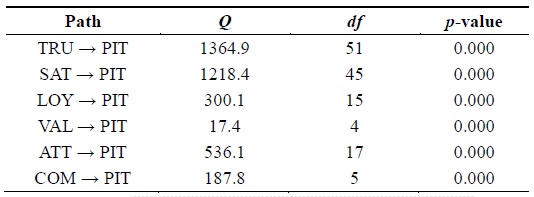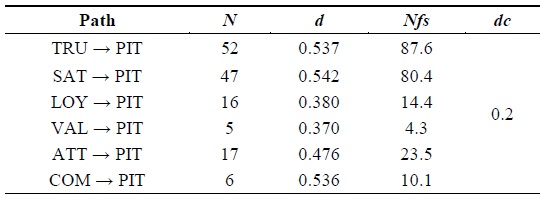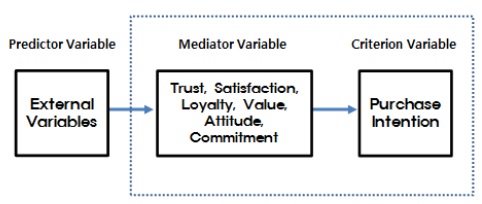



Meta-analysis is a statistical integration method that delivers an opportunity to overview the entire result by integrating and analyzing many quantitative research results. This study will find meaningful mediator variables for criterion variables that affect purchase and repurchase intentions in e-commerce, on the basis of the results of a meta-analysis. We reviewed a total of 114 e-commerce studies published in Korean journals between 2000 and 2014, where a cause and effect relationship is established between variables that are specified in the conceptual model of this study. In this meta-analysis, the path between trust and purchase intention showed the biggest effect size. The second biggest effect size was found in the path between commitment and purchase intention, while the smallest one was obtained with perceived. Thus, we present the theoretical and practical implications of these results and discuss the differences among these results through a comparative analysis with previous studies.
Currently, with the development of information and communication technology (ICT) along with the proliferation of the Internet culture, Internet-based e-commerce has matured and is showing a steady growth trend. As a result, a wide variety of Internet-based business models have emerged. These changes in Internet-based e-commerce have also brought considerable changes in the operation processes, customer communications, and transaction systems of various companies. In 2014, the e-commerce market was expected to have grown to 1 trillion dollars. The competition in the e-commerce market is becoming fierce between industries, as well as within the industry. Recently, the businesses and business (B2B), business and consumer (B2C), and consumer and consumer (C2C) sectors have started using e-commerce. In addition, m-commerce based on cell phones and smartphones is growing rapidly.
On the other hand, a study on the factors related to new products and services that affect potential buyers and induce them to choose these products and services is a very essential and interesting topic to researchers. This can be attributed to the belief that when companies and service providers launch new products and services, they can imprint important factors and remove the concerns of the consumer in order to speed up the adoption and diffusion of these products and services. Further, an analysis of the current customers’ awareness on products and services is helpful to effectively forecast future demands of these products and services. This study will find meaningful mediator variables for criterion variables that affect purchase and repurchase intentions in e-commerce, on the basis of the results of a meta-analysis. In addition, the purpose of this study is a comparative analysis with similar previous studies, in the meta-analysis.
Previous e-commerce research in Korea is mainly focused on online shopping malls and related topics. With the development of ICT and wireless communication technology, the environment of e-commerce is moving from being Internet-based to being cellphone and smartphone based. This movement has promoted active research on e-commerce in the mobile environment.
In previous e-commerce research, researchers studied various combinations of mediator variables to examine their effect on purchase intention, depending on the objectives and directions of the studies. The top mediator variable adopted by many researchers was the trust factor, followed by the satisfaction factor. Further, we could find that many other previous studies on the purchase intention model adopted the factors of both trust and satisfaction.
Many researchers adopted the loyalty factor as the third most important mediator variable. Further, factors of perceived value, attitude, and commitment were adopted to build their models. In general, many re-searchers preferred to combine these mediator variables to build their models, instead of employing these factors independently. Other researchers adopted factors of perceived risk, usefulness, ease of use, playfulness, involvement, and word-of-mouth and discredit. Hence, in this study, we constructed a conceptual model to find meaningful factors that affect purchase intention in ecommerce research, as shown in Fig. 1.
To determine the effect of the abovementioned factors on purchase intention, we selected a few studies from the field of e-commerce. In [1], Joh stated that the excellent quality of agricultural products satisfies consumers and increases the trust of the shopping mall, and eventually connects consumers to purchase intention. In [2], the author identified that the satisfaction factor has positive effects on trust, repurchase intention, and positive viral marketing. In [3], the authors revealed that mediator variables of e-satisfaction and e-loyalty have significant effects on repurchase intention.
After reviewing 72 previous domestic and foreign studies in a meta-analysis on online trust, Baek [4] reported that the effect size of a weighted mean between trust and purchase intention is
Meta-analysis is a statistical integration method that provides an opportunity to overview the entire result by integrating and analyzing many quantitative research results [5]. Meta-analysis is sometimes expressed as an analysis of another analysis. Meta-analysis is quantitative, so we use the summary statistics through simple data integration. Further, by calculating the effect size, researchers can convert results of studies where different scales and methods are used, into common units and thus, can integrate and compare these results. Moreover, a generic conclusion can be drawn through a meta-analysis. In addition, a small difference between studies can be neglected for generalization even when different effect sizes are used [6].
This study investigated e-commerce studies published in Korean journals between 2000 and 2014, where a cause and effect relationship is established between the dependent variable, purchase intent, and other variables of trust, satisfaction, loyalty, perceived value, attitude, and commitment. Social science research paper data-bases, including KISS, DBpia, and RISS, were searched to find relevant Korean journal papers, with the key-words of ‘e-commerce purchase intention,’ ‘online purchase intention,’ and the ‘Internet shopping purchase intentions.’ Search results displayed a total of 792 papers, including 570 papers through RISS, 118 papers through DBpia, and 104 papers through KISS. Only 150 papers out of these 792 well expressed the cause and effect relationships between purchase intention and mediators. From this pool, 114 papers that met the conditions of the conceptual model of this study were selected and analyzed for the final meta-analysis.
The homogeneity test in the meta-analysis was performed on these research subjects to find that the effect sizes of multiple independent studies are values extracted from the same population. The null hypothesis for the statistical homogeneity test is that there is no difference in the estimated effect sizes of the individual study results. Therefore, if the null hypothesis is proved, we can perform a meta-analysis to obtain estimates of the overall effect size by incorporating effect size estimates. The interpretation of the homogeneity test is based on a chi-square distribution for the test statistic,
[Table 1.] Results of homogeneity test

Results of homogeneity test
The most problematic issue of integrating studies for the meta-analysis is the one related to study bias where unpublished papers were integrated with published papers into this study sample. Unpublished papers cover cases in which researchers may commit errors with insignificant research results, miss the right time of publication, and/or not meet the screening requirements of the reviewers. These problems are called publication bias, or the file drawer problem, and are explained to commit Type I mistakes [10]. This implies that papers published in journals have a high likelihood of positive results as compared to unpublished papers.
In the meta-analysis, we review the validity of the research by checking the deflection possession through the stability factor, or the concept of fail-safe
[Table 2.] Results of calculation of fail-safe number

Results of calculation of fail-safe number
The purpose of this study is to classify and re-analyze the results of previous studies, which contain cause and effect relationships between trust and purchase intention, satisfaction and purchase intention, loyalty and purchase intention, perceived value and purchase intention, attitude and purchase intention, and commitment and purchase intention with respect to e-commerce. In this study, were viewed a total of 114 e-commerce research papers published in Korean journals between 2000 and 2014, where a cause and effect relationship is established between the variables specified in the conceptual model of the present study. Based on information from these literature reviews, paths presented in the conceptual model of this study are converted to values of average effect size by using calibrated inverse variance weighting values and a random-effects model, as shown in Appendix.
After considering the meta-analysis results in detail, first, we concluded that the path between satisfaction and purchase intention had the largest effect size of (
Next, the effect size in the path between trust and purchase intention is (
Finally, with a small number of studies, the effect size in the path between loyalty and purchase intention is


